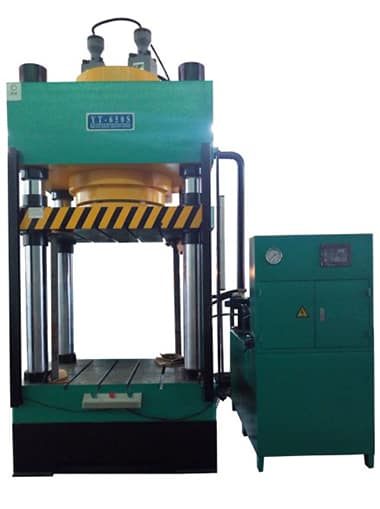How to Make a Hydraulic Forging Press Dies
time:2023-07-27 views:(点击 997 次)Forging presses - either mechanical or hydraulic - are widely utilized for impression die and large open die forging, providing more controlled energy delivery with more time available for shaping of workpiece.
This article will describe various types of forging press machines and their uses, along with safety features that make these forging presses safe for operation.
Hydraulic system
Hydraulic forging presses are machinery used to shape metal by compressing it under high pressure, making it into various shapes from various metal types. They are essential tools in many manufacturing operations and should always be stored in a secure area to avoid contaminants entering. They require large amounts of force when operating and their equipment must withstand the high pressure required. A hydraulic system using pressurized fluid generates enough force while being safely stored away to avoid dirt entering through cracks in its framework.
Press forging is a type of forging which uses slow and continuous pressure to create parts with complex shapes such as break levers, nuts, bolts and screws. Press-forged components can be found in many cars and trucks as well as agricultural equipment, oilfield parts, tools and military ordnance.
Mechanical and hydraulic forging presses are two primary types of forging presses. Mechanical presses utilise a crankshaft to apply consistent length strokes to an upwardly operating ram that exerts force against metal. Mechanical forging presses are generally preferred for lower profile forgings as they feature knockout/liftout pins that eject finished forgings from their dies - this feature helps reduce weight as well as subsequent machining costs.
Hydraulic forging presses offer greater consistency than mechanical presses due to being operated via computer-controlled force application, providing for precise forming operations and helping ensure quality finished products. Furthermore, their hydraulic system offers greater versatility for working with different materials - even high temperature metals!
Hydraulic forging presses offer greater accuracy and tolerance control compared to forging hammers, and are energy efficient enough to achieve faster production speeds. They can even produce parts in one step for maximum time and cost savings; additionally, hydraulic forging presses are capable of creating complex shapes without forging hammers, as well as handling larger tonnages.
Ram
A forging press utilizes a vertical ram to apply gradual, controlled pressure to a die holding the workpiece, similar to drop forging but providing greater plastic deformation uniformity with fewer defects than other production methods. They may be mechanical, hydraulic, servo motor or pneumatic. They can produce parts in many shapes and sizes from small to large that include nuts and bolts, rivets screws brake levers bearing races as well as those containing close tolerances, sharp corners or intricate designs.
Mechanical forging presses are the most commonly used form of forging press. This device is typically powered by a motor connected to a flywheel which stores energy for release when moving the ram, then applies force against workpiece to shape into desired form. This process can create various shapes; particularly effective when dealing with alloys with moderate ductility that would shatter under direct impact from a hammer; it is used in production of metal components for automobiles, aerospace equipment, agricultural equipment, oilfield equipment and tools and hardware production.
Hydraulic forging presses are more complex than their mechanical counterparts, but offer greater control of the squeezing process. Hydraulic pressure comes from an attached cylinder connected to a ram and uses Pascal's law for control. Although these machines take more time and contact time with workpiece, they are capable of producing precision forgings at consistent quality levels with minimal wear on precision tools; making them suitable for isothermal forging processes as well as producing components used in aerospace, agricultural equipment, oilfield parts and military ordnance production processes.
Die
Forging is a form of deformation which employs large amounts of force to shape metal parts into complex forms with great precision. This process creates intricate forms with accurate dimensions, making countless types of metal products such as nickel alloys particularly easy to shape with deep protrusions of up to six times their thickness as well as tight tolerances and sharp corners - perfect for production runs!
Forged parts play an integral part in several industries, such as automotive, aerospace, agricultural equipment, oilfield parts, tools and hardware, military ordnance and others. Autos contain up to 200 press forged parts produced through forging processes; their strength and quality provide key components of an automobile's structure. Furthermore, this technique can produce both ferrous and non-ferrous materials as well as hard-to-machine pieces like lug nuts, bolts rivets screws and brake levers which would otherwise require intricate machine work to produce.
Hydraulic presses used for open die forging enable a greater variety of shapes to be formed than other forging methods, making them suitable for mass production of nuts, bolts and fasteners. Capable of producing up to 50 strokes per minute with close tolerance control over temperature ranges - they offer greater freedom than their predecessors in forging techniques.
Forging can remove defects like shrinkage, porosity and alloy segregation that would otherwise require extensive machining and increase strength of finished pieces. Unfortunately however, press forging is limited by its lack of precision and limited metal types that can be forge forged.
Hydraulic quick die change systems for forging applications can increase productivity while lowering maintenance costs, often by using wedge clamps with tapered wedges that match die tapers. This ensures consistent hydraulic forces and secure locking of wedges. Furthermore, these systems are easy to install and use; often being utilized for short runs of just-in-time production.
Safety features
Forging metal requires immense pressure to shape it into specific forms. A forging press uses its hydraulic system to generate that force and shape metal pieces. It consists of four main components: frame, ram, hydraulic system and die. Each element works to produce desired form: push against die from above with ram pushing against die below while hydraulic pressurize working fluid pressurize machine from top. Dies are heat treated and rough machined while the ram made of special type of steel.
A forging press is an automated machine designed to produce multiple parts per hour. These machines are frequently used in industries that need complex pieces of metal such as automobiles or industrial equipment, as they produce complex shapes quickly. A forging press can perform various functions including cold extrusion, forging and sheet drawing - as well as creating components from these processes for automobiles or other industrial equipment. They require regular training of employees as well as inspection to avoid fatal accidents from occurring.
Forging presses can be either mechanical or hydraulic and employ either a crank or screw shaft to spin their ram. They deliver energy more slowly than hammers, and are therefore better suited to alloy groups requiring slower deformation rates. Furthermore, forging presses create less stress in dies that helps lower weight and machining costs while being less likely to break after shorter run-in periods than hammers.
Safety features on a forging press should include user-friendly touch panels with easy navigation features that enable operators to easily access mold and rework equipment, large tools and provide plenty of lighting for inspections. In addition, rotating platen features should further maximize daylight levels so dies can be checked more easily for inspection or rework.
Link to this article: https://www.ihydraulicpress.com/nsn/3999.html
Hot Articles
-
How to Make a Small Hydraulic Hash Press
Hydraulic hash presses are an efficient and straightforward method for extracting solventless concentrates, producing clean and high-grade extract……
-
How to Make an Air Over Hydraulic Press
Air over hydraulic presses offer an energy-efficient and quieter alternative to full hydraulic presses, and are easier to maintain with fewer part……
-
How to Make a Hydraulic Press
If you need to apply massive pressure in your workshop, a hydraulic press may be just what’s needed. These versatile machines offer benefits t……
-
How to Make a Ring Using a Hydraulic Press
Hydraulic presses are widely utilized in industrial manufacturing to shape everything from wiper blades and automobile parts, to wiper blades them……
-
How to Make a Pizza Hydraulic Press
Though many pizzerias still use the traditional method of stretching dough by hand, high-volume operations may need to streamline their process with……
-
How to Make an Electric Hydraulic Press
Hydraulic presses use Pascal’s law to generate incredible force, producing such immense pressure that it can crush metal tools and cars with……
-
How Much Force Does a Hydraulic Press Exert?
Hydraulic presses play an integral part of many manufacturing processes. Utilizing Pascal’s Law, these powerful machines produce immense force……
-
How to Make a Hydraulic Press
If you have seen an unusual metal sink made out of one piece of sheet metal or witnessed modern blacksmiths working their craft, chances are the h……
Latest News
-
How to Make a Hydraulic Press Model
If you require tons of pressure, a hydraulic press may be just what’s needed. Its moving component follows steel guides which ensure horizon……
-
How to Make a Wooden Hydraulic Press
Hydraulic presses can be an indispensable asset when it comes to DIY projects, from glueing woodwork together and crushing objects to creating briqu……
-
How to Make a Hydraulic Press Machine
Hydraulic presses can be invaluable tools in the workshop, providing immense amounts of pressure onto objects. But rather than buying one commercial……
-
How to Make an Electric Hydraulic Press
Electric hydraulic presses can be used for numerous applications, including metal forming, powder compacting and plastic molding. Their operation wo……
-
How to Make a Manual Hydraulic Press
Manual hydraulic presses are powerful machines capable of producing considerable force. These presses can be used for various tasks, including sam……
-
How Much Force Can a Hydraulic Press Generate?
Few manufacturing technologies can rival the powerful capabilities of a hydraulic press. No metal can resist being crushed under its immense force……
-
How to Make a Hydraulic Press for Knife Making
A hydraulic press is a machine that uses mechanical or hydraulic force to shape metal. Compared with screw or upsetter presses, its operation is m……
-
How to Make a Hydraulic Press Juicer
Hydraulic press juicers are specialized juicing machines that employ hydraulic pressure to extract juice from raw produce. There are various model……














































